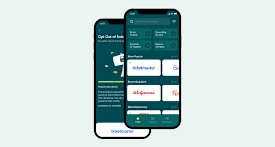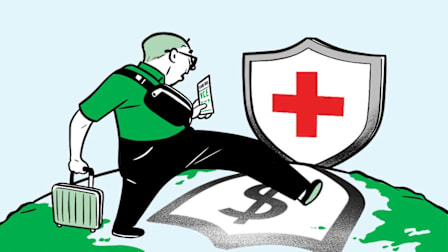How to Protect Yourself From a Massive Medical Bill
Even with Medicare, if you suffer a serious illness, your costs can be very high. Here's how to avoid unaffordable bills.

It can happen so quickly. One day, you’re feeling fine. The next, you’re dealing with a serious diagnosis, possible surgery, multiple medications, physical therapy, the works. You want to focus on getting better, but it’s hard when the bills start rolling in. Maybe you thought Medicare was going to be enough. It might not be.
In fact, more than three-quarters of people over 65 will be told at some point that they have a serious or chronic medical condition, according to the National Center for Health Statistics. Another report by the Employee Benefit Research Institute says a couple in retirement would need as much as $350,000 to pay for their healthcare even if they have Medicare and an average supplemental plan.
So what can you do if you get big medical bills? According to Frederic Riccardi, president of Medicare Rights, a consumer advocacy organization, don’t panic. There are ways to amp up your coverage and negotiate bills in order to lower or even eliminate them. (See “Hit With a Big Medical Bill? Do This.”)
First, though, know that making changes to your Medicare coverage can go a long way toward stemming the tide of bills, whether you have a sudden illness or you’re continuing to deal with something chronic. Here, the questions to ask yourself right now, and what to do to protect your money.
Check Your Insurance
Perhaps when you signed up for your plan at age 65 you were in pretty good shape, taking blood pressure meds and multivitamins but not much else. Then maybe you developed some more serious issues.
As a result, if you’re on original Medicare, sometimes known as traditional Medicare, your out-of-pocket costs for deductibles, copays and coinsurance are getting out of hand. Or if you’re on a Medicare Advantage plan, maybe the specialist you need to see is not in your network. Or the prescription drug you need isn’t covered well—or at all—which can happen no matter which type of plan you’re on. Don’t worry: You do have choices, Riccardi says.
Protect Your Assets From Big Bills
Perhaps you had a bad bout of food poisoning that landed you in the hospital for a few days. Or you had a heart attack and required time in a rehab center. Even with the best coverage, a serious illness can leave you on the hook for more money than you can afford. Our advice: Don’t pay any medical bill until you’ve confirmed that it’s accurate and you’ve explored options to mitigate its cost. (See “Hit With a Big Medical Bill? Do This.”) Here are ways to find those funds.
Tap Your Life Insurance
If you have a permanent life insurance policy (whole or universal) it may have an “accelerated death benefit” rider that allows you to withdraw 25 to 100 percent of the policy’s value if you have a chronic condition, need to be admitted to a long-term-care facility, or have received a terminal illness diagnosis.
If that’s not an option, you could sell your policy—what’s known as a “viatical settlement.” While not usually a great choice for people who wish to leave funds to family members, the lump sum it provides can help offset medical costs, says Melissa Cox, an independent certified financial planner in Dallas who specializes in retirement planning. Contact your insurance company to start the process.
Another idea: You might be able to take out a loan on the policy if it has accrued enough value. The only risk here: If you can’t pay it back, there will be less of a payout to your beneficiaries when you die.
Before paying any medical bill, confirm that it’s accurate and explore options to help trim its cost.
Take Out a Home Equity Loan
Compared with personal loans, which can start at 11 percent interest, home equity loans start at around 7 percent and may be tax-deductible.
Another option is to borrow against your home with a reverse mortgage, Cox says. These loans pay you a lump sum or a monthly amount based on the home’s value and your age. They also charge monthly fees and interest.
These are tricky loans, so if you decide to go this route, make sure you fully understand the terms. Also, add your spouse or live-in partner as a co-borrower. Then, in the event of your death, they can remain in the home and continue to receive money from the loan.
Apply for Financial Assistance
Nonprofit hospitals are required to offer some portion of their services as “charitable care,” and you do not always have to be low-income to qualify for it, says Lisa Berry Blackstock, founder of Soul Sherpa, a medical billing and estate planning company. Be sure to ask about this option because hospitals won’t always let you know it’s available. Another way to find out whether a hospital has charitable care you qualify for is to check at Dollar For, a nonprofit that tracks thousands of charitable care programs and offers free help applying.
When to Consider Medicaid and How to Qualify
You may hope to stay in your home for the rest of your life. But circumstances might mean you need more substantial healthcare than your family or hired caregivers can provide. When you consider that a private room in a nursing home can cost upward of $116,000 per year and is not covered by original Medicare or Medicare Advantage, you may need to turn to your state’s Medicaid program.
To qualify, you’ll have to show that you have limited assets—the amount varies by state. For 2024 in New York, for example, an individual seeking nursing-home care must earn less than $1,732 a month and have no more than $31,175 in assets, not including their home, car, and wedding rings, according to the American Council on Aging.
One way to prepare to meet those limits is to set up a Medicaid Asset Protection Trust, a type of irrevocable trust. You place assets like your home, stocks and bonds, and certificates of deposit into the trust—a legal arrangement where someone you appoint holds those assets on your behalf. In this way, you no longer own the assets—the trust does.
In addition to helping you qualify for Medicaid, the arrangement also prevents creditors from going after these assets. A few things that usually don’t go into the trust: your Social Security benefits, IRA, 401(k), and pension. Additional beneficiaries, such as your spouse or children, can be named when you form the trust.
Editor’s Note: This article also appeared in the November/December 2024 issue of Consumer Reports magazine.




















